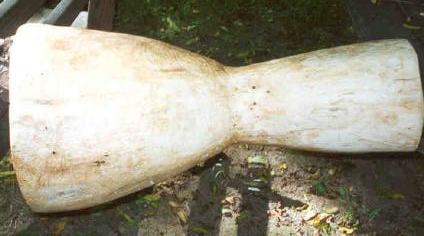my woods buddies,
triplet deer born
last spring.
I also view them
as potential future
sources of drum heads
(read on).
This was shot from
my back door. These
darlings were about
50 feet away.

|
Here's some of
my woods buddies, triplet deer born last spring. I also view them
This was shot from
|
 |
Ok enough nature. Let's delve into philosophy and acoustics. "If a tree falls and nobody is there to hear it, it can still make a noise, If You Make It Into a Drum!!"
I wasn't there to hear it, because I was out of town when the winter wind storm caused a huge maple tree to fall in the back yard. The elder tree really was a sacred relic, with a trunk diameter at the ground of about 3 feet. It broke off at a point about 10' off the ground.
Of course my first thought was "firewood!!" So in the snow I went out and lopped off the upper (actually outer, laying well into my neighbor's yard) branches which were already dead and dry, and harvested the rich bounty of burnable wood for the remainder of the winter.
As spring approached, I got a strange idea to attempt to carve a drum from somewhere in the tree. I polled friends who had different types of single-log carved drums, collecting dimensions. I decided to carve an African-style Djembe, and selected a hunk from just below where the tree had broken off. The dimensions I decided to shoot for were 13-14" diameter head, 27" total height (14" base and 13" top "goblet"), 9" diameter at base.
|
Here is the tree
as it rested in my yard, with the chunk removed that I would use to carve my drum. |  |
| So here's the new
saw, on a hunk of stump, next to the beginnings of my djembe carving |

|
| Just to prove
it's really me carving this drum (or at least me sitting next to a drum in progress). |

|
|
Notches in the
top to facilitate hollowing it out |

|
|
So why don't more
people hollow drums out of solid trees? Because the wood splits.
|

|
|
After carving is
pretty much done, I haul it inside and glue the heck out of it. Giant hose clamps and cardboard padding, carpenter's wood glue, and a de- humidifier to help it dry. |

|
| Dry it out some more |

|
| Sand it smooth |

|
|
Prep the surfaces
for staining |

|
| Stain it |

|
| Seal it with PolyUrethane |

|
So far so good right? Looking like a real wooden acoustic drum now, right? But i'm a music technologist at heart and by profession. And I can't work on something without thinking up things to improve on the design, or at least mess with it a lot. I got an idea to make a "Roto Djembe." What's that?
|
Well here's a RotoTom.
You can tune it quickly
Rotating causes a
|

|
|
The bottom of
the RotoTom. |

|
|
I sawed the lower support
spider to fit inside the Djembe shell. |

|
|
Then glued the spider inside
the drum. This required quite a
|

|
|
I lined the top of the
djembe rim with neoprene. |

|
|
and put the top
roto-rim in place. |

|
|
A view of the tuning
handle from the bottom of the drum. |

|
|
After deciding that it
would be just too gross to actually work with a raw deerskin (see top picture), I decided to order a 15"
|

|
At this point, I needed to read up some on how to head and rope african drums. The Aegis site had a pretty good guide on re-heading an already roped drum. I also found a dizzying description which only an eagle scout on steroids could read without passing out. Finally I dug in and began to rope the drum.
|
Lower ring with
decorative yarn wrap, and loops strung for verticals. |

|
|
Verticals begin.
You can also see the crown ring and loops peeking out from beneath the fur on the top right. |

|
|
All done!!
Top shot of completed drum |

|
|
Full frontal shot of
completed Djembe. Gotta tame that unruly
|

|
So what does it sound like? Not perfect yet, but here's the first recording of it.
|
So i took the next step:
I took out the roto junk
and roped up the drum as a regular old djembe.  |
I also hollowed out the top section some more,
hoping to increase the resonance.  |
Things were going quite well, almost getting it to sound like a real drum.
|
Just a couple...
more... tightening steps... and........ POP!!!! The head broke. Sheesh. |
 |
So I got another goatskin
Aegis Thunderhead kit
from bongocentral.com
and roped it up again. Things went pretty well this time, and here's the final result:
| Listen to it |  |
| But, it's still not
as good as a real Djembe made by a true master from Ghana. Here I've shown the least attractive side of my drum, next to a wonderfully crafted true African drum.
Hear the difference here.
|
 |